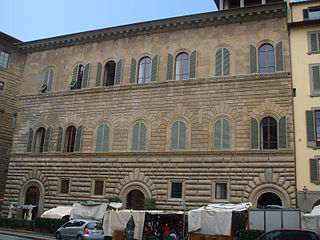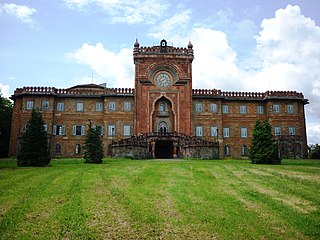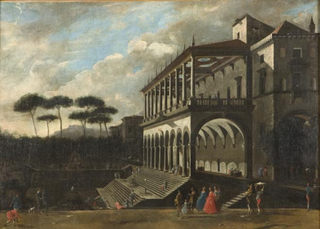
Renaissance architecture is the European architecture of the period between the early 15th and early 16th centuries in different regions, demonstrating a conscious revival and development of certain elements of ancient Greek and Roman thought and material culture. Stylistically, Renaissance architecture followed Gothic architecture and was succeeded by Baroque architecture. Developed first in Florence, with Filippo Brunelleschi as one of its innovators, the Renaissance style quickly spread to other Italian cities. The style was carried to Spain, France, Germany, England, Russia and other parts of Europe at different dates and with varying degrees of impact.

Giuliano da Sangallo was an Italian sculptor, architect and military engineer active during the Italian Renaissance. He is known primarily for being the favored architect of Lorenzo de' Medici, his patron. In this role, Giuliano designed a villa for Lorenzo as well as a monastery for Augustinians and a church where a miracle was said to have taken place. Additionally, Giuliano was commissioned to build multiple structures for Pope Julius II and Pope Leo X. Leon Battista Alberti and Filippo Brunelleschi heavily influenced Sangallo and in turn, he influenced other important Renaissance figures such as Raphael, Leonardo da Vinci, his brother Antonio da Sangallo the Elder, and his sons, Antonio da Sangallo the Younger and Francesco da Sangallo.

Antonio da Sangallo the Younger, also known as Antonio da San Gallo, was an Italian architect active during the Renaissance, mainly in Rome and the Papal States.

Baldassare Tommaso Peruzzi was an Italian architect and painter, born in a small town near Siena and died in Rome. He worked for many years with Bramante, Raphael, and later Sangallo during the erection of the new St. Peter's. He returned to his native Siena after the Sack of Rome (1527) where he was employed as architect to the Republic. For the Sienese he built new fortifications for the city and designed a remarkable dam on the Bruna River near Giuncarico. He seems to have moved back to Rome permanently by 1535. He died there the following year and was buried in the Rotunda of the Pantheon, near Raphael.

Prato is a city and comune in Tuscany, Italy, the capital of the Province of Prato. The city lies in the north east of Tuscany, at the foot of Monte Retaia, elevation 768 metres (2,520 ft), the last peak in the Calvana chain. With more than 200,000 inhabitants, Prato is Tuscany's second largest city and the third largest in Central Italy.

The Villa Farnesina is a Renaissance suburban villa in the Via della Lungara, in the district of Trastevere in Rome, central Italy.

Montepulciano is a medieval and Renaissance hill town and comune in the Italian province of Siena in southern Tuscany. It sits high on a 605-metre (1,985 ft) limestone ridge, 13 kilometres (8 mi) east of Pienza, 70 kilometres (43 mi) southeast of Siena, 124 kilometres (77 mi) southeast of Florence, and 186 kilometres (116 mi) north of Rome by car.

Palazzo Strozzi is a palace in Florence, Italy.

Palazzo Fenzi is a palace in Florence, Italy.
The Florentine banking family of the Gondi were prominent financial partners of the Medici. Unlike the Medici, they were of the old Florentine nobility, tracing their line traditionally from the legendary Philippi, said to have been ennobled by Charlemagne himself, in 805; from him the Strozzi and the Gualfreducci also claimed their descent. With Orlando Bellicozzo, a member of the Great Council of Florence in 1197, the Gondi emerge into history, receiving their patronymic from Gondo Gondi, sitting on the Great Council in 1251, signatory to a treaty between Florence and Genoa in that year. In the fourteenth century several members of the family sat on the Great Council. Simon de Gondi renounced the Ghibelline party for himself and his house, in 1351; he loaned the Republic 8000 golden florins in a time of extremity. He held extensive lands round Valcava, in the Mugello, where the church bore the Gondi arms inside and out. Of Simon's seven children, his grandson another Simon was the first of the Gondi to hold the position of Grand Prior of the Republic, on three occasions. His daughter Maddalena, who married Giovanni Salviati, by the marriage of her daughter Maria with Giovanni dalle Bande Nere, became the grandmother of Cosimo I de' Medici; thence were descended all the Catholic crowned heads of pre-Napoleonic Europe. Carlo de Gondi was a staunch backer of Piero de' Medici, and when the Medici came to be Grand Dukes, the Gondi received empty but honorary titles of Senators.

Piazza Santa Croce is one of the main plazas or squares located in the central neighbourhood of Florence, in the region of Tuscany, Italy. It is located near Piazza della Signoria and the National Central Library, and takes its name from the Basilica of Santa Croce that overlooks the square.

Maria Anna of Savoy was a Princess of Savoy by birth and Duchess of Chablais by her marriage to her uncle, Prince Benedetto, Duke of Chablais.

Palazzo Gondi is a palace in Florence, Italy, located a block from Piazza della Signoria. It was built in 1490 under design by Giuliano da Sangallo, who was inspired by other major works of stately buildings in the city, such as Palazzo Medici and Palazzo Strozzi. Among the elements borrowed from these earlier works are the cube-shape set around a central courtyard, the ashlar sloping on each of three floors, and the arched windows.

Sammezzano, or the Castle of Sammezzano, is an Italian palazzo in Tuscany featuring Moorish Revival architectural style. It is located in Leccio, a hamlet of Reggello, in the Province of Florence.

The Poggio Reale villa or Villa Poggio Reale was an Italian Renaissance villa commissioned in 1487 by Alfonso II of Naples as a royal summer residence. The Italian phrase "poggio reale" translates to "royal hill" in English. The villa was designed and built by Giuliano da Maiano and located in the city of Naples, in the district now known as Poggioreale, between the present Via del Campo, Via Santa Maria del Pianto and the new and old Via Poggioreale. At the time it was built, a period when the capital city of the Kingdom of Naples was renowned for elegant homes with expansive vistas of the surrounding landscape and Mount Vesuvius, the villa was outside the city walls of Naples and was one of the most important architectural achievements of the Neapolitan Renaissance. Imitated, admired, robbed of its treasures by another king, left in ruins and partially destroyed, the summer palace of the King of Naples lives on in name as a style.

The Palazzo Panciatichi is a Renaissance palace located on Via Camillo Cavour 2 in the quartiere of San Giovanni, Florence, region of Tuscany, Italy. A different Palazzo Panciatichi-Ximenes or Ximenes-da Sangallo is located at Borgo Pinti 68, corner of via Giusti, in Florence.

The Medici Villa of Poggio a Caiano, also called Ambra, is one of the most famous Medici villas and is located in Poggio a Caiano (Prato). Today it is state owned and it houses two museums: one of the historic apartments and the Museum of Still Life.
This is an alphabetical index of people, places, things, and concepts related to or originating from the Republic of Venice. Feel free to add more, and create missing pages.















